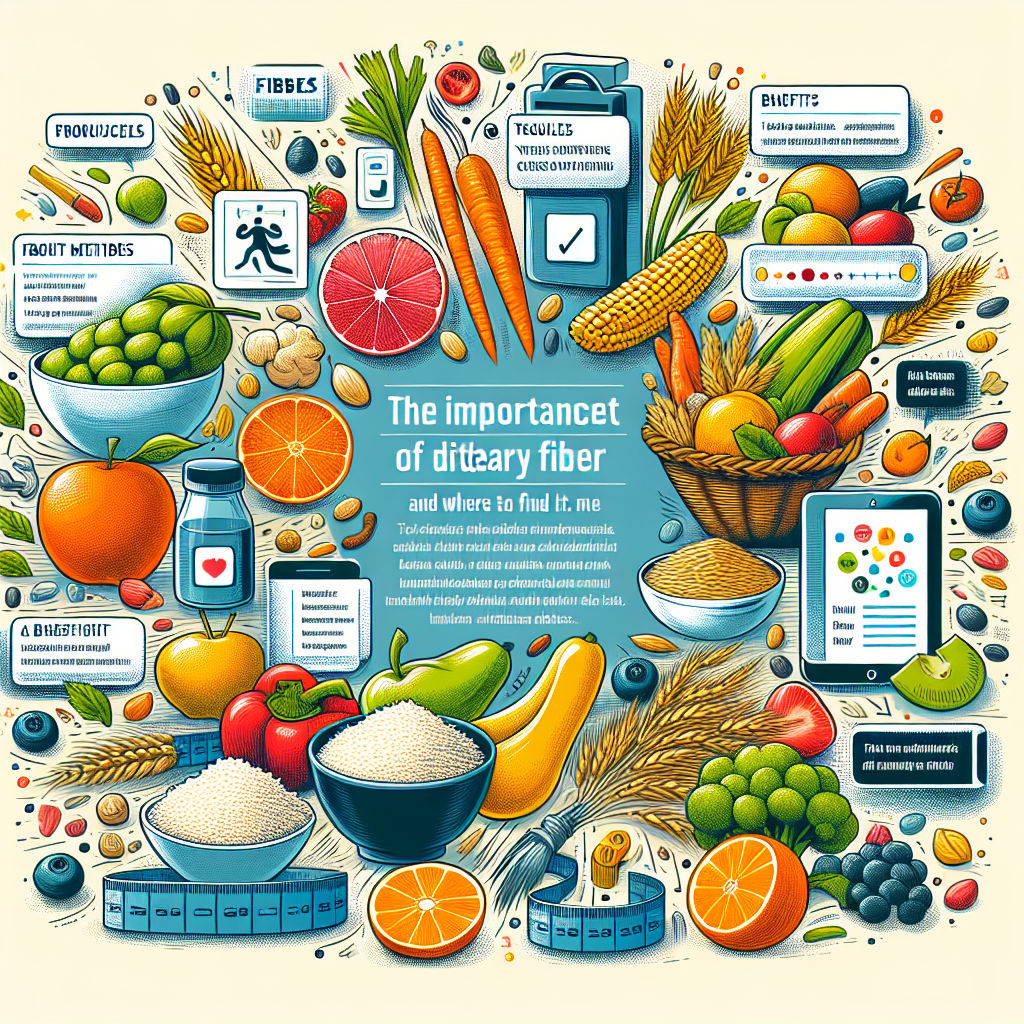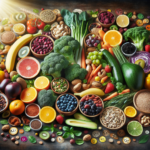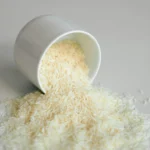Are you looking to improve your overall health through nutrition? If so, you may have wondered about the importance of dietary fiber and where to find it. A balanced diet is essential, and this includes knowing the right calorie intake, protein sources, and the significance of vitamins and minerals. Incorporating healthy fats and dietary fiber into your diet can have numerous benefits. Additionally, understanding the nutritional differences in organic foods, making healthy choices while dining out, staying properly hydrated, and reducing sugar consumption are all practical concerns. Nutrition education is key in making informed dietary choices that support a healthy lifestyle. So, let’s explore the importance of dietary fiber and discover where you can find it.

In This Article
ToggleThe Importance of Dietary Fiber
What is dietary fiber?
Dietary fiber, often referred to simply as fiber, is a type of carbohydrate that cannot be digested by the human body. Unlike other nutrients such as proteins and fats, fiber passes through the digestive system relatively intact. It is found in plant-based foods such as fruits, vegetables, whole grains, legumes, nuts, and seeds.
The role of dietary fiber in the body
Dietary fiber plays a crucial role in maintaining a healthy digestive system. It adds bulk to the diet, which helps prevent constipation and promotes regular bowel movements. Fiber also helps regulate blood sugar levels by slowing down the absorption of sugar into the bloodstream. Additionally, it aids in weight management by providing a feeling of fullness and reducing the risk of overeating.
Health benefits of consuming dietary fiber
Consuming an adequate amount of dietary fiber offers numerous health benefits. It helps lower cholesterol levels, thus reducing the risk of heart disease. Fiber also plays a vital role in managing and preventing certain chronic diseases, such as type 2 diabetes and colorectal cancer. It improves gut health by promoting the growth of beneficial bacteria in the colon. Furthermore, fiber contributes to a healthy weight by keeping you satiated and aiding in weight loss efforts.
Types of Dietary Fiber
Soluble fiber
Soluble fiber can dissolve in water and forms a gel-like substance in the digestive tract. It helps lower cholesterol levels and stabilizes blood sugar levels. Good sources of soluble fiber include oats, barley, legumes, and fruits such as apples and citrus fruits.
Insoluble fiber
Unlike soluble fiber, insoluble fiber does not dissolve in water. It adds bulk to the stool and aids in preventing constipation. Insoluble fiber can be found in whole grains such as wheat bran, brown rice, and whole wheat bread.
Resistant starch
Resistant starch is a type of fiber that behaves similarly to soluble fiber in the body. It resists digestion in the small intestine and reaches the colon, where it provides nourishment for beneficial bacteria. Foods high in resistant starch include green bananas, legumes, and cooked and cooled potatoes.
Functional fiber
Functional fiber refers to isolated or extracted fibers that are added to foods or supplements. It is often used to boost the fiber content of processed foods. While functional fiber may have some health benefits, it is recommended to prioritize naturally occurring sources of dietary fiber.
Recommended Daily Intake of Dietary Fiber
Fiber recommendations for men
The recommended daily intake of fiber for adult men is around 38 grams. However, the average intake of fiber for men is generally lower than this recommendation. Increasing fiber consumption can greatly benefit men’s overall health and well-being.
Fiber recommendations for women
Adult women should aim for a daily fiber intake of approximately 25 grams. However, similar to men, most women fall short of meeting this goal. By incorporating fiber-rich foods into their diet, women can enhance their digestive health and reduce the risk of various diseases.
Fiber recommendations for children
Children should consume an appropriate amount of fiber based on their age and caloric needs. A general guideline is to consume at least 14 grams of fiber for every 1,000 calories consumed. Encouraging children to eat a variety of whole fruits, vegetables, and whole grains can help them meet their fiber needs.
Sources of Dietary Fiber
Fruits
Fruits are excellent sources of dietary fiber. They are not only delicious but also packed with essential vitamins and minerals. Examples of high-fiber fruits include apples, berries, pears, bananas, and oranges. Incorporating these fruits into your daily diet can significantly increase your fiber intake.
Vegetables
Vegetables are another group of food that is rich in dietary fiber. Leafy greens like spinach, kale, and broccoli, as well as cruciferous vegetables such as cauliflower and Brussels sprouts, are particularly high in fiber. Adding a variety of vegetables to your meals can help meet your daily fiber requirements.
Whole grains
Whole grains are grains that have not been refined and retain all parts of the grain kernel. They are excellent sources of dietary fiber. Examples of whole grains include oats, quinoa, brown rice, whole wheat bread, and whole grain pasta. Choosing whole grain options over refined grains can significantly increase your fiber intake.
Legumes
Legumes, also known as pulses, are a great source of both soluble and insoluble fiber. They include foods like lentils, chickpeas, black beans, and kidney beans. Incorporating legumes into your diet, whether in soups, salads, or main dishes, can greatly boost your fiber intake.
Nuts and seeds
Nuts and seeds not only provide healthy fats but also contain a good amount of dietary fiber. Almonds, chia seeds, flaxseeds, and walnuts are examples of high-fiber nuts and seeds. Including them as snacks or as toppings in your meals can contribute to meeting your daily fiber requirements.
High-Fiber Foods to Include in Your Diet
Apples
Apples are a delicious and convenient fruit that is high in dietary fiber. They contain both soluble and insoluble fiber, making them an excellent choice for overall health. With their natural sweetness and versatility, apples make for a convenient snack or a tasty addition to various dishes.
Broccoli
Broccoli is a nutrient-dense vegetable that is also rich in dietary fiber. It is a cruciferous vegetable known for its health benefits, including providing a good amount of fiber. Including broccoli in your diet, whether steamed, roasted, or added to stir-fries, can increase your fiber intake significantly.
Oats
Oats are a whole grain that is widely recognized for its high fiber content. They contain a specific type of soluble fiber called beta-glucan, which has been linked to various health benefits. Starting your day with a bowl of oatmeal or incorporating oats into baked goods can be a delicious way to increase your fiber intake.
Kidney beans
Kidney beans are a type of legume that is particularly high in fiber. They are versatile, affordable, and easy to incorporate into your meals. Whether added to soups, stews, or salads, kidney beans can help increase your dietary fiber intake while also providing a good source of plant-based protein.
Almonds
Almonds are a nutritious and fiber-rich nut that can be enjoyed as a snack or added to various recipes. They are not only an excellent source of fiber but also provide healthy fats, vitamins, and minerals. Including a handful of almonds in your daily diet can contribute to meeting your fiber needs.
How to Increase Your Dietary Fiber Intake
Choose whole foods over processed foods
When aiming to increase your dietary fiber intake, it is important to prioritize whole foods over processed foods. Whole foods, such as fruits, vegetables, whole grains, and legumes, are naturally rich in fiber and provide a range of other essential nutrients. Avoiding highly processed foods, which often have low fiber content, can help you boost your fiber intake.
Gradually increase fiber intake
It is recommended to gradually increase your fiber intake to allow your body to adjust. Rapidly increasing your fiber consumption can lead to digestive discomfort, such as bloating or gas. Start by adding one high-fiber food to your diet at a time and gradually increase the portion sizes and variety of fiber-rich foods.
Include a variety of high-fiber foods in meals
To ensure you are getting a good mix of fiber types and maximize your health benefits, include a variety of high-fiber foods in your meals. Combining different sources of dietary fiber, such as fruits, vegetables, whole grains, and legumes, can provide a well-rounded and balanced fiber intake.
Experiment with new recipes and cooking methods
Exploring new recipes and cooking methods can make increasing your fiber intake more enjoyable and sustainable. Look for creative ways to incorporate high-fiber foods into your meals, such as adding vegetables to stir-fries, using whole grains in salads, or trying new legume-based recipes. This allows you to discover new flavors and textures while increasing your fiber intake.
Tips for Incorporating More Fiber into Your Daily Diet
Start the day with a high-fiber breakfast
Starting your day with a high-fiber breakfast can set the tone for a fiber-rich diet. Opt for whole grain cereals or oatmeal topped with fruits and nuts. Including a source of protein, such as yogurt or eggs, can further enhance the satiety and nutritional value of your breakfast.
Snack on fiber-rich foods
Instead of reaching for processed snacks, choose fiber-rich options for your mid-morning or afternoon snacks. Fresh fruits, raw vegetables with hummus, or a handful of nuts and seeds can provide a satisfying and nutritious snack while contributing to your daily fiber goals.
Add vegetables to main dishes
Adding vegetables to your main dishes is a simple yet effective way to increase your fiber intake. Include a variety of vegetables in stir-fries, soups, casseroles, or pasta dishes. This not only adds fiber but also boosts the nutritional value and flavor of your meals.
Replace refined grains with whole grains
Swap out refined grains for whole grains whenever possible. Choose whole grain bread, brown rice, whole wheat pasta, and quinoa instead of their refined counterparts. This small change can significantly increase your fiber intake and improve the overall nutritional value of your meals.
Potential Risks of Consuming Excessive Fiber
Digestive discomfort
Consuming excessive amounts of fiber, especially if increased suddenly, can cause digestive discomfort. This may include bloating, gas, stomach cramps, or diarrhea. To avoid these issues, it is important to gradually increase fiber intake and drink plenty of water to help your body adjust.
Nutrient absorption
While fiber is incredibly beneficial for overall health, consuming excessive amounts of fiber can interfere with nutrient absorption. This is because fiber can bind to certain minerals and prevent their absorption in the gut. To mitigate this risk, it is important to consume a balanced diet that includes a variety of nutrient-dense foods.
Interactions with medication
Some medications may interact with high-fiber diets. Fiber can affect the absorption and metabolism of certain drugs, potentially reducing their effectiveness. If you are taking any medications, it is important to consult with your healthcare provider before making significant changes to your fiber intake.
Dietary Fiber and Weight Management
Fiber’s role in appetite control
Dietary fiber plays a key role in appetite control. High-fiber foods take longer to digest, providing a feeling of fullness and satiety. This can help reduce overall calorie intake and prevent overeating.
Effect on satiety and fullness
Fiber-rich foods promote a sense of fullness and prolong the feeling of being satisfied after a meal. This can prevent excessive snacking and contribute to maintaining a healthy weight.
Contribution to weight loss
Including an adequate amount of dietary fiber in your diet can facilitate weight loss efforts. It helps control cravings, prevents energy crashes, and supports a healthy metabolism. Combined with regular physical activity and a balanced diet, increased fiber intake can be an effective tool for achieving weight loss goals.
Conclusion
Dietary fiber plays a crucial role in maintaining a healthy diet and overall well-being. It aids in digestion, regulates blood sugar levels, lowers cholesterol, and contributes to weight management. By incorporating a variety of high-fiber foods into your daily meals, you can meet the recommended fiber intake and reap the many health benefits. Remember to increase your fiber intake gradually if you are not accustomed to a high-fiber diet and consult with a healthcare professional for personalized advice. Start making small changes today and enjoy the positive impact of dietary fiber on your health.
Related posts:
 What are simple ways to reduce sugar in my diet?
What are simple ways to reduce sugar in my diet?
 How can I ensure I’m getting enough vitamins and minerals?
How can I ensure I’m getting enough vitamins and minerals?
 How can I make healthier food choices when eating out?
How can I make healthier food choices when eating out?
 How much water should I be drinking each day?
How much water should I be drinking each day?
 What are the benefits of eating organic foods?
What are the benefits of eating organic foods?
 What are healthy fats and how can they benefit my diet?
What are healthy fats and how can they benefit my diet?








No comment yet, add your voice below!